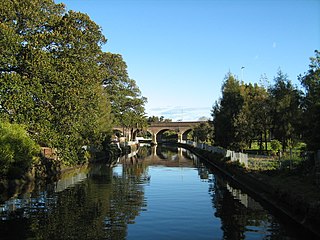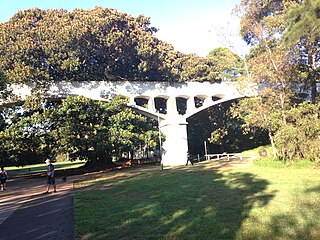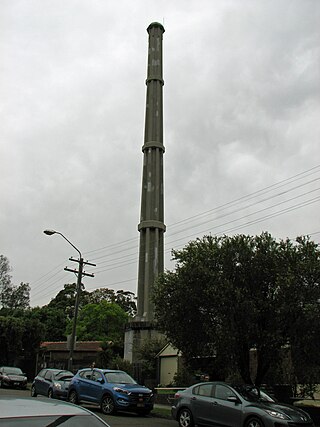
The Tank Stream is a heritage-listed former fresh water tributary of Sydney Cove and now tunnel and watercourse located in the Sydney central business district, in the City of Sydney local government area of New South Wales, Australia. The Tank Stream was the fresh water supply for the fledgling colony of New South Wales in the late 18th century. Today it is little more than a storm water drain. It originated from a swamp to the west of present-day Hyde Park and at high tide entered Sydney Cove at what is now the intersection of Bridge and Pitt Streets in the Sydney central business district. The catchment was 65 hectares, corresponding roughly the size of the Sydney central business district. It was added to the New South Wales State Heritage Register on 2 April 1999.

Johnstons Creek, formerly Johnston's Creek, is an urban gully, located in Sydney, Australia and situated in the Inner West and Sydney local government areas. The creek flows from Petersham, past Annandale, Camperdown, Forest Lodge and Harold Park, before spilling into Rozelle Bay, within Sydney Harbour.

Mosman Bay is a bay of Sydney Harbour adjacent to the suburb of Mosman, 4 km north-east of the Sydney CBD in New South Wales, Australia. Three ferry wharves are within the bay, all being served by the F6 Mosman Bay ferry service.

The Barwon Sewer Aqueduct is a heritage-listed aqueduct across the Barwon River at Goat Island, Breakwater, Victoria, Australia. It was designed by engineer E. G. Stone and was erected between 1913-1915. It would appear to be the only one of its kind in Australia in terms of its length and the use of Considère's construction technique. The aqueduct appears to be the last example in Australia of Armand Considère's system of reinforcing for concrete structures. It was added to the Victorian Heritage Register on 23 October 1991.

Lewisham Sewage Aqueduct is a heritage-listed sewage aqueduct in Gadigal Reserve, adjacent to 5 Grosvenor Crescent, Summer Hill, Inner West Council, Sydney, New South Wales, Australia. It was designed by Sewerage Construction Branch and Department of Public Works and built in 1900. The property is owned by Sydney Water. It was added to the New South Wales State Heritage Register on 18 November 1999.
The Middle Harbour Syphon is a heritage-listed sewerage syphon located at Monash Crescent, Clontarf, Northern Beaches Council, New South Wales, Australia. It was designed by E. M. de Burgh, an engineer in the NSW Public Works Department and was built from 1922 to 1925 by the Department. The sewerage syphon is also known as the Middle Harbour Syphon NSOOS and The Spit Syphon. The property is owned by Sydney Water, an agency of the Government of New South Wales. The property was added to the New South Wales State Heritage Register on 15 November 2002.

The Botany Water Reserves is a heritage-listed area that was historically used as part of Sydney's water supply system. It is located at 1024 Botany Road, Mascot,New South Wales, Australia. The site is now reserved as parkland, also containing a golf course. It was designed by City Engineers, W. B. Rider, E. Bell (1856–1871), and Francis Bell (1871–1878). It is also known as Botany Dams, Botany Swamps, Botany Wetlands, Mill Stream, Bridge Pond, The Lakes Golf Club, Eastlakes Golf Course, Bonnie Doon Golf Club, and Astrolabe Park. The property is owned by Sydney Water, an agency of the Government of New South Wales. It was added to the New South Wales State Heritage Register on 18 November 1999.

Drummoyne Reservoir is a heritage-listed decommissioned elevated service reservoir at Rawson Avenue, Drummoyne, City of Canada Bay, New South Wales, Australia. It was designed by engineer J. G. S. Purvis from the Metropolitan Board of Water Supply and Sewerage and built from 1910 to 1913, with the Board responsible for the construction of the substructure and Poole & Steele Ltd responsible for the tank manufacture. It is also known as WS0038 and Drummoyne Elevated Steel Reservoir. It was added to the New South Wales State Heritage Register on 15 November 2002. Sydney Water sold the property in September 2018 to owners of a chain of childcare centres, who plan to convert the site into a childcare centre while retaining most of the heritage structure.
The Bondi Ocean Outfall Sewer is a heritage-listed sewerage infrastructure at Blair Street, North Bondi, Sydney, Australia. The sewer line commences at the intersection of Oxford Street and College Street in Darlinghurst and then travels in a more-or-less easterly direction for 6.1 kilometres (3.8 mi) passing through a number of suburbs until it reaches Blair Street in North Bondi. It was designed and built by the Public Works Department between 1880 and 1889. It is also known as BOOS (Bondi Ocean Outfall Sewer) and Main Northern Ocean Outfall Sewer. The property is owned by Sydney Water.

Western Outfall Main Sewer is a heritage-listed former sewage farm outfall sewer and now ocean outfall sewer near Valda Avenue, Arncliffe, Bayside Council, New South Wales, Australia. It was designed by the New South Wales Department of Public Works, who built the sewer from 1895 to 1898. It is also known as SWSOOS No. 1, Western Main Carrier and Western Main Outfall Sewer. The property is owned by Sydney Water. It was added to the New South Wales State Heritage Register on 15 November 2002.

The Old Como railway bridge is a heritage-listed former railway bridge and now footbridge and water main carrier over the Georges River between Como and Oatley in the Sutherland Shire Council and Georges River Council local government areas of New South Wales, Australia. It was designed by John Whitton and Dept of Railways and built from 1883 to 1885 by C. and E. Millar. The property is owned by Sydney Water, an agency of the Government of New South Wales. It was added to the New South Wales State Heritage Register on 15 November 2002.

The Cooks River Sewage Aqueduct is a heritage-listed sewage aqueduct located at Pine Street, Earlwood, New South Wales, Australia. It crosses the Cooks River to Thornley Street, Marrickville. It was designed by Sewerage Construction Branch and NSW Department of Public Works and built during 1895 by J. F. Carson, contractor. The property is owned by Sydney Water, an agency of the Government of New South Wales. It was added to the New South Wales State Heritage Register on 18 November 1999.

The Wolli Creek Aqueduct is a heritage-listed sewage aqueduct located at Unwin Street, Earlwood, City of Canterbury-Bankstown, New South Wales, Australia.

The Double Bay Compressed Air Ejector Station is a heritage-listed former sewage pumping station (SPS87) and now decommissioned sewerage infrastructure in Jamberoo Lane, Double Bay, adjacent to the rear boundary of 63 William Street, in the Municipality of Woollahra local government area of New South Wales, Australia. The site of the pumping station and the State Heritage Register curtilage is shown on SHR:01324–Plan 2019, reproduced on the internet page referenced here.

Premier Street Sewer Vent and Cottages is a state heritage-listed sewer vent and cottages at 24 and 26 Premier Street, Marrickville, Inner West Council, New South Wales, Australia. It was designed by the New South Wales Public Works Department, which built it from 1898 to 1900. It was added to the New South Wales State Heritage Register on 15 November 2002.

White's Creek Aqueduct is a heritage-listed sewage aqueduct at Piper Street, Lilyfield, Inner West Council, Sydney, New South Wales, Australia. It was designed by engineer William Julius Baltzer of the New South Wales Public Works Department and built by the Department from 1897 to 1898. The property is owned by Sydney Water. It was added to the New South Wales State Heritage Register on 18 November 1999.

Johnston's Creek Sewer Aqueduct is a heritage-listed sewage aqueduct located in Hogan Park, off Taylor Street, Annandale, Inner West Council, Sydney, New South Wales, Australia. It was designed by William Julius Baltzer, an engineer in the NSW Public Works Department, and built by the Department in 1897. The property is owned by Sydney Water. It was added to the New South Wales State Heritage Register on 18 November 1999.

The Burwood Sewer Vent is a heritage-listed sewer ventilation stack located at Railway Parade in the Sydney suburb of Burwood, New South Wales, Australia. It was designed and built by the Metropolitan Board of Water Supply and Sewerage in 1919. It is also known as Wentworth Road Sewer Vent and Railway Parade Sewer Vent. The property is owned by Sydney Water, a statutory corporation of the Government of New South Wales. It was added to the New South Wales State Heritage Register on 15 November 2002.

The Croydon Sewer Vent is a heritage-listed sewer ventilation stack located on a small parcel of land adjacent to 12 Paisley Road, Croydon, New South Wales, a suburb of Sydney, Australia. It was designed and built by the Metropolitan Board of Water Supply and Sewerage in 1922. It is also known as Sewer Vent and Paisley Road Sewer Vent. The property is owned by Sydney Water, a statutory corporation of the Government of New South Wales. It was added to the New South Wales State Heritage Register on 15 November 2002.

The Ultimo Sewage Pumping Station is a heritage-listed sewerage pumping station located at William Henry Street in the inner city Sydney suburb of Ultimo in the City of Sydney local government area of New South Wales, Australia. As a result of the construction of an elevated roadway along William Henry Street, the pumping station now fronts Pyrmont Street, with vehicles being required to enter via Quarry Street, then turning right into Pyrmont Street.




















